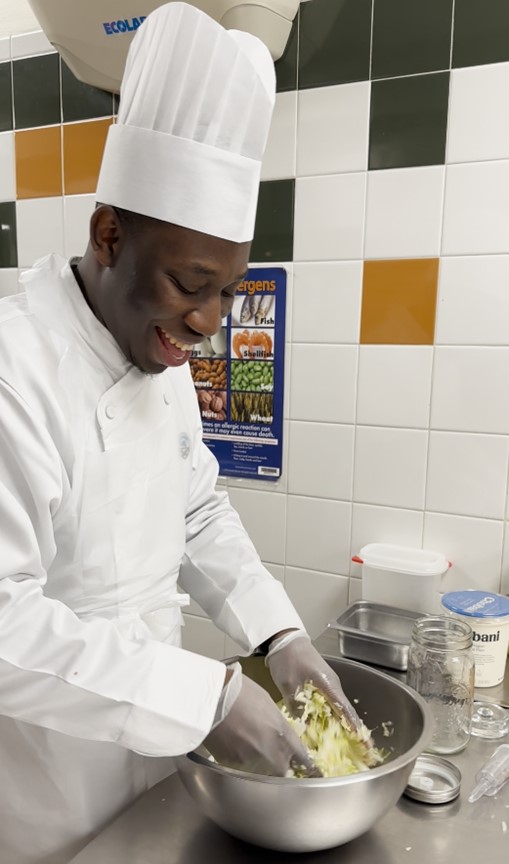‘Gbenga Sadik, 2023
Spring Break at JWU: Student Experiences

The Food Bubble!
I spent spring break chopping, mixing, baking, talking, and eating – the last two being my favorite activities. It was an amazing experience with the College of Food Innovation and Technology at Johnson and Wales University, thanks to the Food and Nutrition Innovation Institute at Tufts University. Beyond the amazing meals I enjoyed and the cooking techniques I learnt, the experience made me to think deeply about how the food and nutrition system is structured. We often talk about food and nutrition as consisting of strings of interconnected systems, disciplines, and institutions, like a web, where each part has a significant role but relies on other parts to function optimally. While this is the idea in principle, the food and nutrition systems hardly functions this way in practice.
Prior to visiting the College of Food Innovation and Technology at JWU, I could not boast of any significant exposure to the culinary world. This is despite having spent four years studying Human Nutrition as an undergraduate, and an additional four years doing community nutrition research, nutrition policy, and teaching. Many food and nutrition systems professionals go through decades of their career, however impactful, without any significant culinary training or experience. But when you consider that every advocacy, research, and innovation on food and nutrition systems comes down to serving food on a plate, you realize that our web is really a bubble.
My experience in the culinary bubble through the lenses of CFIT at JWU was an entirely different world from what I have been used to. Their relationship with food is not just about science, or economics, or culture, or health – it is all of that, plus art. They are not only concerned about making bread that contains x-grams of carbohydrate, fibre, and sodium, but they make sure the bread’s crust has a uniform color and a distinct cut-style. It is difficult – some say impossible – to make a meal that is healthy, good for the environment, affordable, culturally sensitive, yet looks, smells, and tastes good. However, my experience in the culinary bubble convinces me that this is possible. There are extremely brilliant chefs, students, and administrators constantly innovating with food in ways that we never thought was possible, and involving them in the food and nutrition systems conversation will be beneficial to all.
Another insightful experience I had at the leading institution for culinary education in the country is that the culinary world is really not a bubble. I was able to observe how every aspect of the food and nutrition system reflected in their processes and activities, beyond what happened in the kitchens or laboratories. For example, outside the main building are raised beds made of recyclable materials, used to grow vegetables that are utilized for food preparation in the kitchens – this makes an interesting case for the re-localization of agriculture, the future of food production. This level of innovation extends to food storage, food waste management, distribution, service, technology, sales, and even humanitarian aid. Primarily a teaching facility, the CFIT can stand side by side with the largest food production facilities in the world, with tons of meals being prepared in the kitchens and labs daily. For such a facility, food systems innovation is inevitable.
Knowing that there are at least 34 million people in America who cannot afford basic meals, moreso the luxurious ones, I could not help but wonder – what happens to all the excess food? The college processes about 900,000USD worth of food annually! I was glad to learn that a great amount of the meals produced by the students in the kitchens ends up in the hands of food insecure people in their immediate community, through food rescue clubs and nearby food pantries. Currently, nearly 40% of all food in America is wasted, and it is important for all food and nutrition system stakeholders to be at the forefront of addressing this issue.
Finally, the food system cannot function as a bubble – it is a live and active stream of unending, processes, strategies, and innovation, linking every element together to ensure that every individual has access to a healthy and adequate diet. My experience at CFIT tells me that this is possible, but it will take the collective effort of every player in the field.